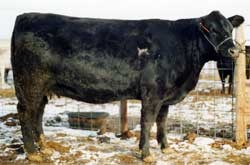A Breed of His Own
Warren Levang has developed 'Black Max' to triumph in a value-based world
by Laura Sands
There's an old joke that asks what you'd end up with if you tried to design a horse by committee. Answer: a camel.
Don't bother telling that joke to Billings, Montana cattle breeder Warren Levang. He won't laugh. His method of developing a breed includes listening to a lot of ideas. There is hardly a theory Levang can bear to miss, an opinion he won't want to hear--not that he doesn't have plenty of theories and opinions of his own. He thinks fast, talks faster, shooting ideas at the rate some people spit watermelon seeds.
This may put him about as far from the Western silent type as you can get, but that's all right with Levang. He sees this incessant information exchange as part of the process of breeding cattle.
"I want to be the guy that solves problems, not the guy who says we can't do it," he says. "If someone has a better idea or a way to fix something, I want to hear it."
It is not every mid-range cattle producer who has the audacity to try to develop a new cattle breed. But Levang has high hopes for his new breed, called Black Maximizer--hopes that his design-by-committee approach has yielded, not a camel, but an animal to help move the industry into the next, value-based century. That was his aim: to improve efficiency for all phases of the industry, from producer to packer. And that's why he interviewed, traveled, studied--and took the team approach.
"I wanted to consider everything from the problems of the cow-calf producer, through the feedlot and into the packer," says Levang, "not just look at one phase."
"The preliminary data on the cattle is very intriguing [see sidebar]," says Marge Head, a research and development specialist at Monfort who has followed Levang's efforts. And though it is too early to know exactly how Black Maximizer will bear out, she's watching Levang's progress carefully.
"Warren has done his homework," Head says. "He has a game plan. Now he has to follow through." That's a big job.
"It takes a tremendous amount of capital and lot of cattle to prove your program," says Tom Kemph, a Montana genetics consultant. "If you don't have the resources, you may have a good product and still not get it going."
Levang, who has spent up to $70,000 so far--and will spend another $50,000 this year just on contracted calves--knows he is up against some industry powers with deep pockets. But he isn't exactly working alone.
"He is able to utilize other people's resources very well," Kemph says.
Levang's has been a Leachman Cattle Co., cooperator herd for many years. He has built a small but solid Simmental purebred operation. And he has forged leasing alliances with many other producers who share the risk; they helped him build a commercial cattle herd of 350 in just seven years, without long-term debt. He has also managed to draw other outside investors. In short, he is an old hand at pooling resources with other farmers and ranchers--a characteristic that Virginia agricultural economist David Kohl predicts will distinguish the next century's agricultural success stories.
"They will be able to do more with less risk together than on their own," he says.
And, adds Montana State University geneticist Don Kress, the small guy is not at such a disadvantage when it comes to breeding cattle that will do well in a value-based world. They may be able to move more quickly to adapt to new markets.
"A fairly high percentage of progressive producers are looking forward to value-based marketing and think they can get the cattle that will do well," adds Kress.
Information is an equalizer between small and large producers--so it's not surprising that Levang spends lots of time at his computer. Combine the right information, the right numbers and the right cattle, he says, and the right producer can gain bonuses in the marketplace. Levang is convinced that if they try hard enough, producers can use the information gathered by feedlots and other sources--such as the National Beef Quality Audit--to make this a more efficient, more consumer-driven industry.
"Value-based marketing is here. The days of junk cattle receiving the same price as good will be short lived," says Levang.
It won't just be producers who are finding their niche in the marketplace. Levang says the whole industry will have to metamorphise, especially to compete with chicken and poultry. "Our chain is only as strong as its weakest link," adds Levang. "We must all be willing to change if necessary, for the good of our future."
Consultant Kemph says that change isn't happening yet: He estimates less than 10% of cattle operations have a focused breeding program that will make an impact in the value-based marketplace. Other cattle producers will stand back and watch the effect that focused breeding efforts like Levang's have on the value-based segment of the marketplace. A rough shakeout is likely.
"There are a lot of people right now that think they have the animal," says Kemph. "Some of them have it. But it is going to take a lot of time to identify them and it is going to be expensive."
Levang plans to be in it for the long haul. "I'll be there in 10 years," he insists.


